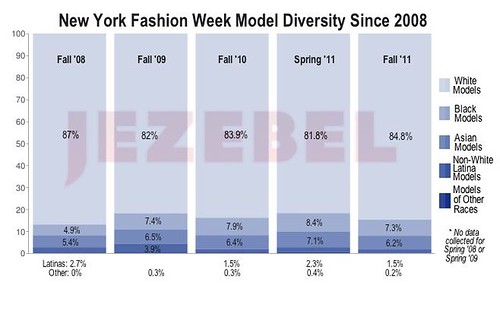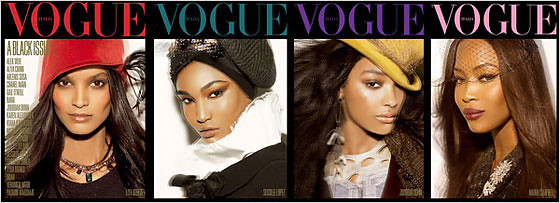Jezebel reported that this New York Fashion Week was one of the least diverse that had occurred in several years with 15.3% of the looks being displayed on non-white models. For comparison, Spring 2011 Fashion Week, occurring only a few months ago had 18.2% non-white representation.

jezebel.com
Regardless of any setbacks in NYFW, it still was the most diverse of the four major fashion weeks this season. After painstakingly going through each and every show from NY, London, Milan and Paris, New York greatly out-shown the other fashion capitals in terms of diversity.
London wasn't terribly far behind at about 12%. Milan and Paris, however, fared very poorly with 7% and 8% respectively. I wonder is these differences may be, in some way, indicative of each country's own relationships with race and diversity. Italy itself, though, has shown inroads in terms of racial diversity in their fashion industry, with an entire issue of Vogue Italia devoted to black models about three years ago.

nymag.com
But that aside, three things stood out about the use of minority models. The first was that much of their use seemed to be from a few designers. While almost all had at least one minority model, only a relative few had those models representing more than 20% of their runway shows. These included Thierry Mugler (33%), Zac Posen (27%) and Hermes (24%) at Paris FW; C'N'C Costume National (26%) at Milan FW; Issa London (56%), Holly Fulton (48%) and Sass & Bide (27%) at London FW; and Duro Olowu (71%), L.A.M.B. (54%) and Tracy Reese (48%) at NYFW.
The second was that many of the designers that used a greater number of minority models are younger designers or those generally considered edgy, such as Rachel Roy and Proenza Schouler. This is one aspect of this that gives me hope. That younger designers are less tied to old standards and expectations and, thus, more likely to be change that many think is needed in the fashion industry. They are, to put it stereotypically, the future of this industry. It helps, too, that many of these younger designers are minorities themselves.
The last aspect that stands out is that much of the minority representation was in a handful of models who participated in the great number of the shows. While I didn't take numbers on this one, some of the models used extensively included Rose Cordero, Hyoni Kang and Joan Smalls. What's more interesting is that these minority models aren't simply random faces in a sea of models, they're becoming big names.
I think there's still a long way for the fashion industry to go, but I don't think that these setbacks will represent larger shifts in the industry. The industry always has and will continue to change, hopefully for the better over the long term.
No comments:
Post a Comment